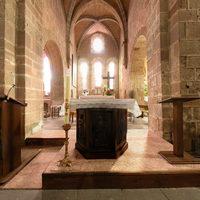Overview
Parish of the diocese of Clermont, confirmed in 1105 by Paschal II to the abbey of Tournus. The church was the seat of a Benediectine priory in the presentation of the prior of S-Pourçain. Church built of ashlar with minimal interior articulation; the modern rubanné re-pointing unfortunately conveys a very hard stony look to the interior. A four-bay barrel-vaulted nave flanked by groin-vaulted aisles is intersected by a projecting transept which opens on to a two-bay choir with flat east end. The work belongs to the second part of the twelfth century: ribbed vaults appear in the crossing and choir. Their early-looking profile (two toruses divided by keel in the choir and three toruses in the crossing) and corbelled installation suggest that the idea of rib vaults was introduced into a building planned for barrel and groin vault. The nave thus comprises the earlier part of the structure, perhaps built during the later 12th century and the choir around 1200 The nave was almost certainly built from east to west, with a slight change in fenestration indicating that the two western bays are slightly newer. There is a discrepancy in the articulation of the nave arcades: there are round arches in the northern aisle, while the southern aisle has pointed arches. This may indicate that the latter was built later than its northern counterpart. The bell tower from around 1200, which raises two stories above the crossing, is notable in its lavish articulation. It is interesting to note that heavy corbels span the façade and half of the northern façades. These were seemingly functional, and not decorative, perhaps used as supports, during a restoration campaign. Finally, the level of the roof has been raised. The earlier roof would have rested directly above the vault, with separate roofs covering the main vessel and side aisles, leaving an exposed clerestory wall, as seen at Murat, Buxières-les-Mines, and Châtel-de-Neuvre. The new roof, which covers the entire nave, is far steeper than the original roof, and certainly more effective in preventing water damage.


